“I answered all questions. What else can I say?”
Today, August 18, 2016, witness Suoy Sao was probed on questions relating to purges of Division 310 and the possibility of a planned coup d’état. He first seemed to indicate that he was present in a meeting during which the latter was discussed, but later refuted the claim. He also denied that he was involved in transporting weapons to Phnom Penh for this coup, something he had indicated in his interview and first seemed to confirm in his testimony today.
Division 310
All parties were present, with Nuon Chea following the hearing from the holding cell. Trial Chamber President Nil Nonn was still absent and replaced by Judge Ya Sokhan. Witness Suoy Sao was born in 1956. The floor was handed to the Nuon Chea Defense Team to question the witness. The witness joined the revolution in 1972. He joined Division 310. Mr. Koppe asked whether this division was also called the First Division or Division 1, which the witness confirmed. He was in regiment 11. He had not heard of Division 920. He confirmed that Division 1 belonged to the North Zone. The commander of Division 1 was called Ta Oeun. Mr. Koppe wanted to know who the chief of the North Zone was. Mr. Sao replied that he did not know this person.
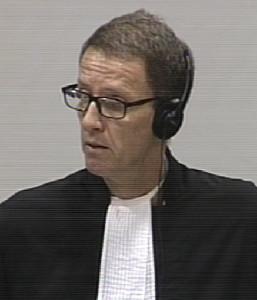
International Nuon Chea Defense Counsel Victor Koppe
After the liberation of Phnom Penh, he was stationed in Tuol Kork. He was transferred to an area called Kak Srao later on. He worked in a rice field there. After leaving the area, he had to fight the Vietnamese troops in Kampong Cham. He was withdrawn subsequently and lived in a village. He was a combatant throughout the Democratic Kampuchea regime. Mr. Koppe showed a list to the witness. He confirmed that he knew Voeung, who was the divisional commander.[1] He did not know number six of the list. Nor did he know Comrade Song or Comrade Ying, Huon (Secretary of Battalion 311), Mak (Secretary of Battalion 312) or Tham (Secretary of Battalion 315). He heard of Chan Chakrei. He was part of the East Zone. He did not know whether he was stationed in the North Zone beforehand. Since the witness had mentioned Hun Sen in his interview, Mr. Koppe then asked whether Hun Sen was part of North Zone forces. Mr. Sao replied that he did not know. Mr. Koppe said that Division 310 combatant Sem Hun had seen Hun Sen being part of Division 310.[2] He did not know a person called Tol. Ta Oeun, his commander, was arrested. He was arrested, because he “staged a coup”. Mr. Sao said: “He wanted to topple Pol Pot’s regime”. This was in the middle of a year. Mr. Koppe wanted to know whether he could recall a meeting, during which that was discussed. He answered that he could not recall this, since he was “at the back”. He did not know how many people were involved in the coup d’état. Mr. Koppe read an excerpt of the witness’s interview, in which he had talked about an attack to Phnom Penh.[3] Mr. Sao said that this information was correct. The plan was “to topple Khieu Samphan”. He did not know about specific places that should be attacked. He did not know about the radio station being supposed to be attacked. His only task was to bring a truck of weapons to Phnom Penh.
Mr. Koppe said that he had talked about a warehouse with weapons.[4] The witness could not remember further details on this.
Mr. Koppe read another excerpt and asked whether it was correct “if we could not defeat Pol Pot, we would call for Vietnam” and inquired whether this was something Ta Oeun had told him.[5] Mr. Sao said that this was correct. Mr. Koppe quoted his DC-Cam statement: “they planned to call for help from the yuon.” Mr. Sao confirmed that he had told DC-Cam this.
Mr. Koppe referred to a female combatant (2-TCW-1030), who had talked about a meeting.[6] Mr. Sao said he could not recall. The North Zone forces, including Division 310, should attack Phnom Penh from the North, and the East Zone forces from the South.
Mr. Koppe asked about Ta Sao Phim in the East Zone and Koy Thuon in the North Zone. He did not know who Sao Phim was. This prompted Mr. Koppe to read an excerpt of his statement, in which he had said that he was transferred somewhere to stay with Sao Phim. He did not see Sao Phim personally. He was at Kandal Chrum when the body of Saom Phim was transferred.
Mr. Koppe read out another excerpt, in which the witness had said that “[Pol Pot] forces did not touch ordinary people” after the uprising.[7] Mr. Sao confirmed having said this.
Arrest of Combatants
Mr. Koppe referred to the statement of 2-TCW-1032, who had about Ta Tuch, who was in charge of a ministry.[8] Mr. Koppe wanted to know whether this helped remember the person, which Mr. Sao denied. Mr. Koppe then referred to another witness’s Written Record of Interview, in which it was indicated that Ta Oeun was working together with people from the Ministry of Commerce.[9] Mr. Sao replied that he did not see this himself. Mr. Koppe then wanted to know whether he knew what kinds of weapons he transported in the truck. The witness answered that he had his own AK-rifle. Mr. Koppe said that the witness had talked about weapons from China that were used by Ta Oeun.[10]Mr. Sao confirmed this, but said he could not remember the specific types of weapons. He did not know which country the weapons he transported came from. He did not know the number of weapons that were transported in the vehicle. He learned about the attack when his leader was arrested. The combatants who transported weapons were not arrested. Neither did he know whether combatants were sent to Kampong Chhnang Airport, nor did he know whether they were transported to Prey Sar.[11] Mr. Koppe referred to statistics of the Armed Forces, but the witness could not provide more details. He said that only leaders were arrested, but did not provide insight how he knew this. Mr. Koppe wanted to know what he meant when he said that “only Hun Sen’s cliques have taken confiscated property”.[12] The Deputy Co-Prosecutor Dale Lysak objected and said this question was irrelevant. Mr. Koppe said that he wanted to know whether this referred to contemporary issues or to the period 1975 until 1979.
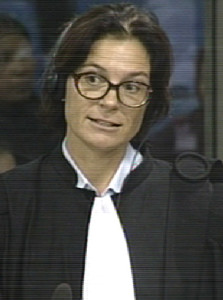
International Lead Co-Lawyer Marie Guiraud
International Civil Party Lead Co-Lawyer Marie Guiraud said that the sentence did not appear in French. Mr. Koppe replied that “There must be a French conspiracy then”. National Civil Party Lead Co-Lawyer Pich Ang read the Khmer original: “how could the interested be obtained, because the properties had been lost.” The witness answered that he did not know. When Mr. Koppe said that the statement read out by Mr. Ang did not clarify the matter and when Mr. Koppe seemed to suggest that the other parties prevented from obtaining more clarity on purpose (“Hun Sen will surely be happy about your intervention here”), Ms. Guiraud interjected and said that this was clearly a technical translation error, and that Mr. Koppe should refrain from suggesting that it was not.
Limited Knowledge about Disappearances
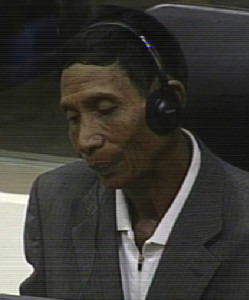
Witness Suoy Sao
International Deputy Co-Prosecutor Dale Lysak commenced his line of questioning and asked the witness to check the biographical details that were indicated in a document.[13] Mr. Sao confirmed the information and that it was his biography. Mr. Lysak referred to an answer in his biography, in which he had indicated that he joined the revolution on 1 January 1975, while he had said today that he joined the Khmer Rouge in 1973, and told DC-Cam that he joined them in 1974. He now said that he made his statement previously that he joined the Khmer Rouge in 1972. He repeated again that he joined them in 1972. He said that he was sent at this time to join the fight in Phnom Penh at this time. He confirmed that he was in Company 1. There were 100 soldiers in his company. The chief was arrested and taken away. This was “during the time of the fighting”. Some of his former fellow combatants of Company 1 died. He could not remember names of the combatants. Mr. Lysak said that an S-21 List identified 1,135 members of his division 310 were sent to that prison. Mr. Lysak inquired whether he was “not aware” that hundreds of fellow combatants disappeared or were arrested. Mr. Sao answered that he did not know much about disappearances. He could not remember the total number, but said that there were less than 100 attendees in a meeting in Phnom Penh. He did not attend many meetings. Mr. Lysak inquired whether it was correct that he did not have much information about the activities or plans of the top leaders of his division. He replied that he did not know much about it. He rarely saw his leader Oeun.
Mr. Lysak moved on and inquired about the meeting, in which leaders, such as Sao Phim, were also present. He answered that he had said that he was in the “far back”, because he was far away from them. The meeting took place in Phnom Penh, but he was based in Tuol Kork. He attended the meeting with two or three people with him when they walked to the meeting. He walked openly in the streets.
At this point, the President adjourned the hearing for a break.
Inconsistent Answers
After the lunch break, Mr. Lysak resumed his questioning and referred back to the meeting, in which the witness believed that there was a plan discussed to attack Phnom Penh. Mr. Lysak wanted to know whether it was held outside or inside. The witness replied that he did not know. He now could not remember whether the number of less than a hundred attendees at the meeting was correct. He now said he did not attend the meeting. When Mr. Lysak asked for clarification, he repeated that he did not attend the meeting.
Turning to the next topic, Mr. Lysak referred to the transport of weapons. The witness now said that he did not transport the weapons himself. “I was an ordinary combatant”.
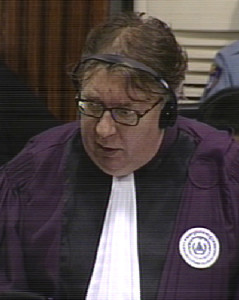
International Deputy Co-Prosecutor Dale Lysak
At this point, Mr. Koppe requested to go into closed session to ask whether the witness had been in any contact with someone during the lunch break. After briefly conferring with the bench, Judge Fenz announced that the request was rejected. When Mr. Lysak probed him further about the meeting, he repeated that he did not know. He had heard about the attacks, but did not know what exactly happened. The people who told him “have all passed away”. He could not recall their names. When Mr. Lysak read an excerpt that indicated that they had played Oeun’s confession, Mr. Sao replied that he did not know. Mr. Lysak inquired whether some of the information that he had told DC-Cam originated from a meeting in which Oeun’s confession were played by new people who had taken over. Mr. Sao again said he did not know. “I answered all questions. What else can I say?”[14]
Mr. Lysak then inquired whether he remember when he was transferred to Kak Sraol. [15] He replied that it took place after the commanders were arrested. Mr. Lysak asked why Oeun would draw the intention of the party to his division if he was planning a coup d’état by reporting to the Center that there were some cadres that planned to revolt. Mr. Koppe objected and said it invited speculation. Mr. Lysak rephrased the question. The witness could not answer the question. Mr. Lysak asked whether he remembered a person who came to monitor the activities of Division 310, which he did not.[16] Mr. Lysak referred to a document that named a person called Orn Chorn, who entered S-21 on July 14 1977 and was executed on July 16, 1977.[17] The witness did not remember that person. As for arrests in his division, he said that commanders had been arrested, but combatants were not.
Meetings
Turning to a different subject, Mr. Lysak wanted to know whether he saw any leaders of Democratic Kampuchea during his time in Phnom Penh, for example in meetings held at the Olympic Stadium. Mr. Sao replied that he never attended any meetings at Olympic Stadium. This prompted Mr. Lysak to refer to his DC-Cam statement, in which he had talked about a meeting at Olympic Stadium during which Khieu Samphan was present.[18] He said that he could not remember. He then said that he stood guard, but could not remember which leaders attended these meetings. This prompted Mr. Lysak to refer to his statement, in which he had said that Khieu Samphan attended it and talked about foreign delegations.[19] He said he could not remember again.
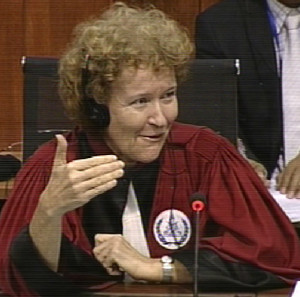
Judge Claudia Fenz
Judge Claudia Fenz interjected and asked whether he had read his statement after having talked to DC-Cam, which he confirmed. He also affirmed that all information in this statement were correct and that he had told the truth. He also confirmed that the information about the meetings in his statement were correct, but that he never attended meetings with divisional commanders.
Mr. Lysak then inquired about the capture of Vietnamese soldiers.[20] He denied knowing anything about this and said that his statement was not correct.
Judge Fenz interrupted and directed her word to the witness: “you can’t have it both ways”. Either the statement was correct, or it was not. Mr. Koppe said that “something obviously happened to him during lunch break” and that they should ask him about it.
At this point, the President adjourned the hearing for a break. After the break, the President announced that the proceedings would be held in camera to decide on the matter.
Mr. Lysak asked whether he witnessed any executions of persons who were connected to East Zone Secretary Sao Phim.[21] He could not provide further information about the issue. He concluded his line of questioning and no other parties had questions they wanted to put to the witness. Mr. Koumjian said that at some point, the public should be informed of the outcomes of the closed session, but Nuon Chea Defense Counsel disagreed. Judge Fenz argued that this information could in no way harm the witness, while Mr. Koppe maintained that a closed session promised the respective witnesses that none of the information would become publicly available. The President adjourned the hearing.
[1] E3/1585, List of Participants During the First General Staff Training, at 00897650 (EN), 00095533 (KH), 00611636 (FR).
[2] 22nd June 2015, at 15:27.
[3] E3/7535, at 00324168 (EN), 00087817 (KH), 00324206 (FR).
[4] E3/7535, at 00324171 (EN), 00087821 (KH), 00324210 (FR).
[5] At 00324173 (EN), 00324210 (FR), 00087822 (KH).
[6] E3/7540, at 00055077 (KH), 00364274 (FR).
[7] 00324181 (EN), 00087837 (KH), 00324226 (FR).
[8] E3/5686, at 00874668 (EN), 00020553 (KH), 00904123 (FR).
[9] E3/509, 00282217 (EN), ending with 159 in Khmer, 00285997 (FR).
[10] At 00324171 (EN), 00087821 (KH), 00324209 (FR).
[11] E3/849, Joint Statistics of the Revolutionary Armed Forces, 7th April 1977, at 00183956 (EN), 00334995 (FR), 00052319 (KH).
[12] E3/7535, at 00324190 (EN), 00087845 (KH), 00324233 (FR).
[13] E3/7535, at 00087683-90 (KH).
[14] E3/7535, at 00087827 (KH), 00234176 (EN), 00324217 (FR).
[15] E3/810, Minutes of 19 September 1976 Secretary Meeting, at 00052393-94 (KH), 00195344-45 (EN), 00195359-60 (FR).
[16] E3/1131; E3/1161.
[17] E3/9954, at 01012060 (KH), number 5099 on OCIJ List.
[18] E3/7535, at 00087815-16 (KH), 00324166-67 (EN), 00324204-05 (FR).
[19] E3/7535, at 00087820 (KH), 00234170 (EN), 00324208-09 (FR).
[20] E3/7535, at 00087832 (KH), 000234180 (EN), 00324222 (FR).
[21] E3/7535, at 00087838 (KH), 00324184 (EN), 00324226-27 (FR).
Featured Image: Witness Suoy Sao (ECCC: Flickr).
